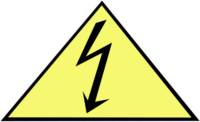2 Never touch knife blades.
3 Use a knife only for its intended purpose; use the appropriate knife for the cutting job.
4 Place a damp cloth under a cutting board to prevent slipping of the board.
5 When interrupted, stop cutting and place knife down on a flat and secured surface.
6 Never place knives near the edge of a countertop.
7 Never leave a knife soaking in a sink of water.
8 Let a falling knife fall. Step back, warn others. Do not try to catch the knife.
9 Carry knives with the cutting edge angled slightly away from your body.
10 To hand a knife to someone else, place it down on a clean surface and let the other person pick it up.
11 Store knives properly in racks or knife sheaths.
Source: Washington State Dept. of Labor and Industries
12 Handle, use, and store knives and other sharp utensils safely.
13 Cut in the direction away from the body.
14 Keep your fingers and thumbs out of the way of the cutting line.
15 Use any protective clothing provided by employer such as steel mesh or Kevlar gloves.
16 Use a knife only for its intended purpose and use the appropriate knife for the cutting job.
17 Store knives, saws, and cleavers in a designated storage area when not in use. Do not store the blades with the cutting edge exposed.
18 Install knife holders on work tables to prevent worker injury.
19 Equip newly purchased knives with blade guards or knuckle guards that protect the hand from slipping onto the blade.
20 Carry knives with the cutting edge angled slightly away from your body, with the tip pointed down to your side.
21 Place a knife that you are handing to someone down on a clean surface and let the other person pick it up.
22 Clean the knife immediately after use or place it in a dishwasher or a container labeled “for knives only.”
23 Avoid placing knives near the edge of a countertop.
24 Do not talk with coworkers while using a knife. When interrupted, stop cutting and place the knife down on a secure surface. Do not try to cut while distracted.
25 Allow only experienced, trained workers to sharpen knives. This is done correctly by keeping the thumb beneath the knuckle guard rim protection on the handle of the sharpener, rather than on top of the rim where it may get cut.
26 Keep knives sharpened and in good condition; dull knives tend to slip and may cause injuries. Tell other staff when knives are newly sharpened.
27 Protect workers who use shake mixer blades. Remind workers to securely hold the top of the container onto the shake cup while mixing to avoid exposure to the blade.
Source: OSHA
28 Retractable blade knives are a good choice for general use, and offer the convenience of being able to quickly adjust the cutting depth of the blades plus the safety of allowing the blade to be retracted completely into the handle when not in use.
29 Snap blade knives are built around a blade designed to snap-off or break away in sections, providing a fresh, sharp cutting point, without having to open the knife. These knives are a good choice for light and medium duty applications, or when adhesive materials like packing tape leave a residue on the blade, making a fresh, sharp edge critical.
30 Special purpose blades (utility, round point, hook, scoring, carpet, linoleum, etc.) are available for a variety of cutting applications.
Source: Stanley Tools


